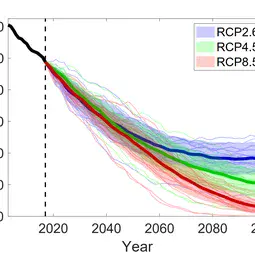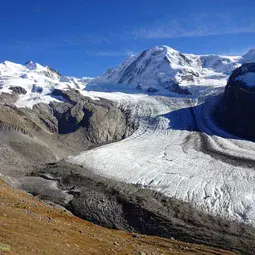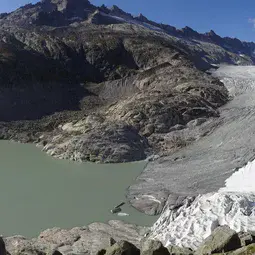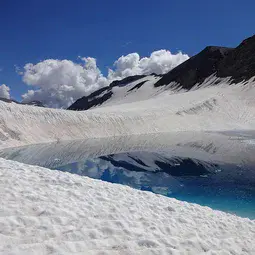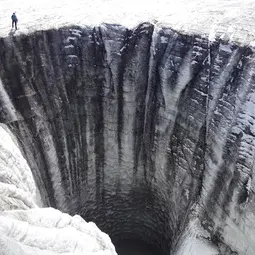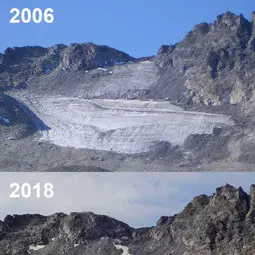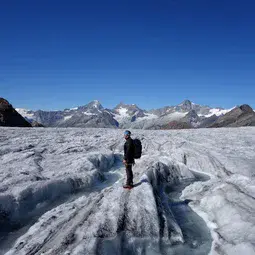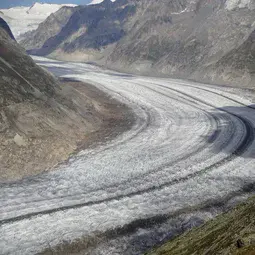More than 90% of glacier volume in the Alps could be lost by 2100
New research on how glaciers in the European Alps will fare under a warming climate has come up with concerning results. Under a limited warming scenario, glaciers would lose about two-thirds of their present-day ice volume, while under strong warming, the Alps would be mostly ice free by 2100. The results, now published in the European Geosciences Union (EGU) journal The Cryosphere, are presented today (9 April) at the EGU General Assembly 2019 in Vienna, Austria.
The study, by a team of researchers in Switzerland, provides the most up-to-date and detailed estimates of the future of all glaciers in the Alps, around 4000. It projects large changes to occur in the coming decades: from 2017 to 2050, about 50% of glacier volume will disappear, largely independently of how much we cut our greenhouse gas emissions.
After 2050, “the future evolution of glaciers will strongly depend on how the climate will evolve,” says study-leader Harry Zekollari, a researcher at ETH Zurich and the Swiss Federal Institute for Forest, Snow and Landscape Research, now at Delft University of Technology in the Netherlands. “In case of a more limited warming, a far more substantial part of the glaciers could be saved,” he says.
Glacier retreat would have a large impact on the Alps since glaciers are an important part of the region’s ecosystem, landscape and economy. They attract tourists to the mountain ranges and act as natural fresh water reservoirs. Glaciers provide a source of water for fauna and flora, as well as for agriculture and hydroelectricity, which is especially important in warm and dry periods.
To find out how Alpine glaciers would manage in a warming world, Zekollari and his co-authors used new computer models (combining ice flow and melt processes) and observational data to study how each of these ice bodies would change in the future for different emission scenarios. They used 2017 as their ‘present day’ reference, a year when Alpine glaciers had a total volume of about 100 cubic kilometres.
Under a scenario implying limited warming, called RCP2.6, emissions of greenhouse gases would peak in the next few years and then decline rapidly, keeping the level of added warming at the end of the century below 2°C since pre-industrial levels. In this case, Alpine glaciers would be reduced to about 37 cubic kilometres by 2100, just over one-third of their present-day volume.
Under the high-emissions scenario, corresponding to RCP8.5, emissions would continue to rise rapidly over the next few decades. “In this pessimistic case, the Alps will be mostly ice free by 2100, with only isolated ice patches remaining at high elevation, representing 5% or less of the present-day ice volume,” says Matthias Huss, a researcher at ETH Zurich and co-author of The Cryosphere study. Global emissions are currently just above what is projected by this scenario.
The Alps would lose about 50% of their present glacier volume by 2050 in all scenarios. A reason why volume loss is mostly independent of emissions until 2050 is that increases in mean global temperature with increasing greenhouse gases only become more pronounced in the second half of the century. Another reason is that glaciers at present have ‘too much’ ice: their volume, especially at lower elevations, still reflects the colder climate of the past because glaciers are slow at responding to changing climate conditions. Even if we manage to stop the climate from warming any further, keeping it at the level of the past 10 years, glaciers would still lose about 40% of their present-day volume by 2050 because of this “glacier response time,” says Zekollari.
“Glaciers in the European Alps and their recent evolution are some of the clearest indicators of the ongoing changes in climate,” says ETH Zurich senior co-author Daniel Farinotti. “The future of these glaciers is indeed at risk, but there is still a possibility to limit their future losses.”
###
Please mention the name of the publication (The Cryosphere) and the General Assembly of the European Geosciences Union if reporting on this story. If reporting online, please include a link to the paper (https://www.the-cryosphere.net/13/1125/2019/) or to the journal website (https://www.the-cryosphere.net).
More information
This research is presented in the paper ‘Modelling the future evolution of glaciers in the European Alps under the EURO-CORDEX RCM ensemble’ published in the EGU open access journal The Cryosphere on 9 April 2019. On the same day, at a press conference, the results were presented at the EGU General Assembly 2019 in Vienna, Austria. The video for the press conference is available at https://client.cntv.at/egu2019/pc5.
Citation: Zekollari, H., Huss, M., and Farinotti, D.: Modelling the future evolution of glaciers in the European Alps under the EURO-CORDEX RCM ensemble, The Cryosphere, 13, 1125-1146, doi:10.5194/tc-13-1125-2019, 2019
The study was conducted by Harry Zekollari (Laboratory of Hydraulics, Hydrology and Glaciology [VAW], ETH Zurich, Zurich, Switzerland & Swiss Federal Institute for Forest, Snow and Landscape Research [WSL], Birmensdorf, Switzerland), Matthias Huss (VAW & Department of Geosciences, University of Fribourg, Fribourg, Switzerland), and Daniel Farinotti (VAW & WSL).
The European Geosciences Union (EGU) is Europe’s premier geosciences union, dedicated to the pursuit of excellence in the Earth, planetary, and space sciences for the benefit of humanity, worldwide. It is a non-profit interdisciplinary learned association of scientists founded in 2002 with headquarters in Munich, Germany. The EGU publishes a number of diverse scientific journals, which use an innovative open access format, and organises a number of topical meetings, and education, policy and outreach activities. Its annual General Assembly is the largest and most prominent European geosciences event, attracting over 14,000 scientists from all over the world. The meeting’s sessions cover a wide range of topics, including volcanology, planetary exploration, the Earth’s internal structure and atmosphere, climate, energy, and resources. The EGU General Assembly 2019 is taking place in Vienna, Austria, from 7 to 12 April 2019. For information and press registration, please check https://www.egu.eu/gamedia, or follow the EGU on Twitter and Facebook.
If you wish to receive our press releases via email, please use the Press Release Subscription Form at http://www.egu.eu/news/subscribe/. Subscribed journalists and other members of the media receive EGU press releases under embargo (if applicable) at least 24 hours in advance of public dissemination.
The Cryosphere (TC) is an international scientific journal dedicated to the publication and discussion of research articles, short communications, and review papers on all aspects of frozen water and ground on Earth and on other planetary bodies. The main subject areas are ice sheets and glaciers, planetary ice bodies, permafrost, river and lake ice, seasonal snow cover, sea ice, remote sensing, numerical modelling, in situ and laboratory studies of the above and including studies of the interaction of the cryosphere with the rest of the climate system.
Contact
Researchers
Harry Zekollari
Department of Geoscience and Remote Sensing
Delft University of Technology, the Netherlands
Phone +32 498 517 901
Email zharry@ethz.ch / h.zekollari@tudelft.nl
Languages English, French, Dutch, Italian
Matthias Huss
Laboratory of Hydraulics, Hydrology and Glaciology (VAW)
ETH Zurich, Switzerland
Phone +41 44 632 40 93
Email mhuss@vaw.baug.ethz.ch
Languages English, German, French
Daniel Farinotti
Laboratory of Hydraulics, Hydrology and Glaciology (VAW)
ETH Zurich, Switzerland
Phone +41 44 632 54 12
Email daniel.farinotti@ethz.ch
Languages English, German, French, Italian
Press officer
Bárbara Ferreira
EGU Media and Communications Manager
Munich, Germany
Phone +49-89-2180-6703
Email media@egu.eu
Twitter: @EuroGeosciences
Links
- Press conference information and link to video
- Scientific paper
- Journal – The Cryosphere
- EGU General Assembly press conferences
- Read this press release in simplified language, aimed at 7–13 year olds, on our Planet Press site


